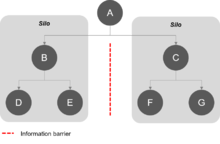Information silo
An information silo is an insular management system incapable of reciprocal operation with other, related information systems.

Information silo occurs whenever a data system is incompatible or not integrated with other data systems. This incompatibility may occur in the technical architecture, in the application architecture, or in the data architecture of any data system. However, since it has been shown that established data modeling methods are the root cause of the data integration problem , most data systems are at least incompatible in the data architecture layer.
In management the term silo mentality often refers to information silos in organizations. Silo mentality is caused by divergent goals of different organizational units. It can also be described as a variant of the principal-agent problem. Silo mentality preferably occurs in larger organizations and can lead to a decreased performance and has a negative impact on the corporate culture. Silo mentality can be countered by the introduction of shared goals, the increase of internal networking activities and the flatting of hierarchies.[1]
Predictors for the occurrence of silos are
- Number of employees
- Number of organizational units within the whole organization
- Degree of specialization
- Number of different incentive mechanisms
This should not be confused with a data silo in computing, like application virtualization, operating-system-level virtualization, or a separation kernel.
Etymology
The term functional silo syndrome was coined in 1988 by Phil S. Ensor who worked in organizational development and employee relations for Goodyear Tire and Rubber Company, Eaton Corporation, and as a consultant. "Silo" and "stovepipe" are now used interchangeably and applied broadly. Phil Ensor's use of the term "silo" reflects his rural Illinois origins and the many grain silos he would pass on return visits as he contemplated the challenges of the modern organizations with which he worked.[2][3][4][5]
See also
- Bounded rationality
- Business process interoperability
- Closed platform (a.k.a. walled garden or closed ecosystem)
- Data architecture
- Data integration
- Data warehouse
- Disparate system
- Enterprise application integration
- Islands of automation
- Metadata publishing
References
- ↑ "Silo mentality in companies". Retrieved 2016-05-26.
- ↑ Ensor, Phil (Spring 1988). "The Functional Silo Syndrome" (PDF). AME Target: 16. Retrieved 2013-10-19.
- ↑ AME Study Group on Functional Organization (Summer 1988). "Organizational Renewal – Tearing Down the Functional Silos" (PDF). AME Target: 4-16. Retrieved 2013-10-19.
- ↑ Pullin, James (Winter 1989). "Breaking Down the Functional Silos: Motorola Paging Division "Bandit" Plant" (PDF). AME Target. Retrieved 2013-10-19.
- ↑ "Of Silos and Stovepipes". Language Log. University of Pennsylvania. 2006-03-27. Retrieved 2013-10-19.